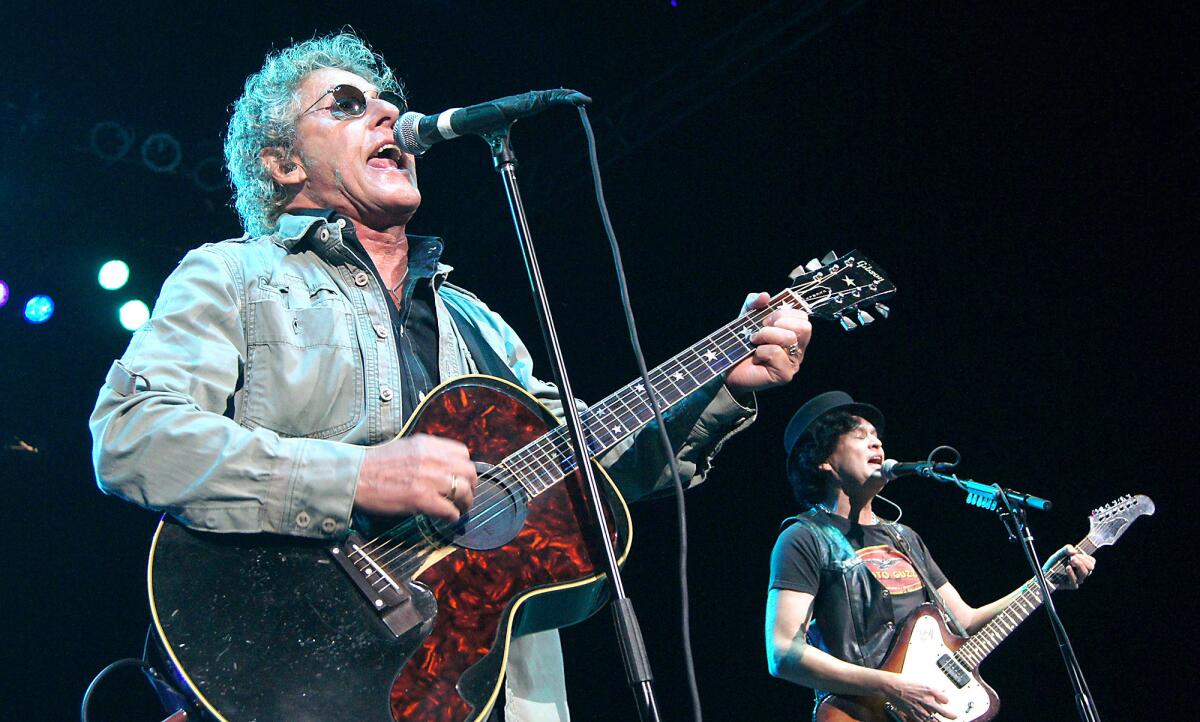City Lights: Daltrey’s talkin’ about another generation

To young cancer patients nationwide, Roger Daltrey is the new boss.
And whatever The Who may have sung decades ago, he’s not the same as the old boss.
That was the thought that crossed my mind when I attended Daltrey’s show Saturday at the OC Fair, then put in a call Monday to the UCLA Daltrey/Townshend Teen and Young Adult Cancer Program, which the singer launched with bandmate Pete Townshend in 2011.
The men who once snarled at those who “try to put us down” are now serving as protectors for a very different generation. The surviving members of a band that some once viewed as a threat to society have devoted their lives to ensuring that the kids are all right.
That’s not to say that they’ve changed, deep down, in the past half-century. They were rockers then and are rockers now, and their hearts may have been as big in 1965 as they are today. But that Daltrey/Townshend sign at the UCLA Medical Center in Santa Monica (doesn’t “Daltrey/Townshend” sound like a law firm or a textbook publishing company?) goes to show how new bosses are born.
It’s pretty simple: They’re born because the old bosses die out. What’s shocking or rebellious once becomes the status quo when its founders become elder statesmen. If you saw the movie “Pirate Radio” a few years ago, it may have served as a reminder of how, half a century back, bands like The Who were seen as capable of destroying a lot more than Keith Moon’s drum kit.
This summer, as Eric Burdon and the Animals got set to play at Costa Mesa’s 60th anniversary celebration, the Daily Pilot reprinted a review of the 1968 Newport Pop Festival by Los Angeles Times critic Digby Diehl. In a pan of the festival, Diehl blamed The Who — which he begrudgingly labeled “a capable musical group” — for pushing rock’s boundaries beyond the pale by smashing instruments and committing other hijinks onstage.
Now, even in 2013, I’ll admit that smashing instruments is a dumb thing to do. Plenty of charities around the world could use them. And some of the excesses of the 1960s seem even more dangerous and destructive than they may have at the time, given the benefit of hindsight.
But now that we’ve reached a time when sex and drugs aren’t so often synonymous with rock ‘n’ roll, we can see what a blessing people like Daltrey gave to us. Even apart from social liberation, the music has held up astonishingly well. While 1950s rock has more or less become a relic, at least in terms of radio play, the songs from the decade afterward have fused themselves into our collective consciousness.
Just the other year, I watched students at the Huntington Beach Academy for the Performing Arts perform the Beatles’ entire “Revolver” album in concert. Visit any community college and try to find a Led Zeppelin T-shirt or Doors window decal; it won’t be hard.
And it may not be hard at the UCLA Medical Center, either. After seeing Daltrey’s show (more on that in a minute), I contacted Becky Mancuso-Winding, the senior director of development for UCLA Health. She told me that every patient admitted to the teen-young adult cancer unit receives an iPod and that music therapy, which includes electric guitar lessons, is among the offered activities.
Do Who songs ever factor into the playlist? Mancuso-Winding said they do — sometimes to the surprise of the patients themselves, who don’t connect Daltrey and Townshend to their catalog until an older adult explains the history.
“Once they start to hear the music and they recognize ‘Tommy’ or recognize these classic songs they’ve heard, they realize, ‘Oh my God, that’s them? And that was done how many years ago?’” she said. “That’s the interesting part of it.”
So, back to the concert. At the Pacific Amphitheatre, Daltrey took the stage amid banners for Teen Cancer America, the charity he founded with Townshend and Rebecca Rothstein, and roared his way through one hit after another: “I Can See for Miles,” “The Seeker,” “Won’t Get Fooled Again” and more. In between plugs for the cause, he performed with his usual gusto, even doing the time-honored move of whirling his microphone cord like a lasso.
When Daltrey came onstage, almost the entire crowd in the lower section stood. A few danced or recorded on iPhones, but most just stood still. Maybe it was for a mundane reason — the front row got up, and then everyone else followed so they could see the stage — but it looked like a massive show of respect, the way a polite child might stand when a grandparent entered the room.
If that was the case, I hope Daltrey enjoys being the boss. And the days of putting down his generation seem to be long over.
MICHAEL MILLER is the features editor for Times Community News in Orange County. He can be reached at michael.miller@latimes.com or (714) 966-4617.